
Cirkit Designer
Your all-in-one circuit design IDE
Home /
Component Documentation
How to Use battery: Examples, Pinouts, and Specs
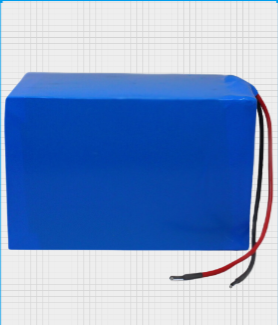
 Design with battery in Cirkit Designer
Design with battery in Cirkit DesignerIntroduction
A battery is a device that stores chemical energy and converts it into electrical energy to provide a steady power supply to a circuit. Batteries are essential components in a wide range of electronic devices, from small portable gadgets to large industrial systems. They come in various shapes, sizes, and chemistries, each suited for specific applications.
Explore Projects Built with battery
Solar-Powered Battery Charger with LED Indicator and Motor Control
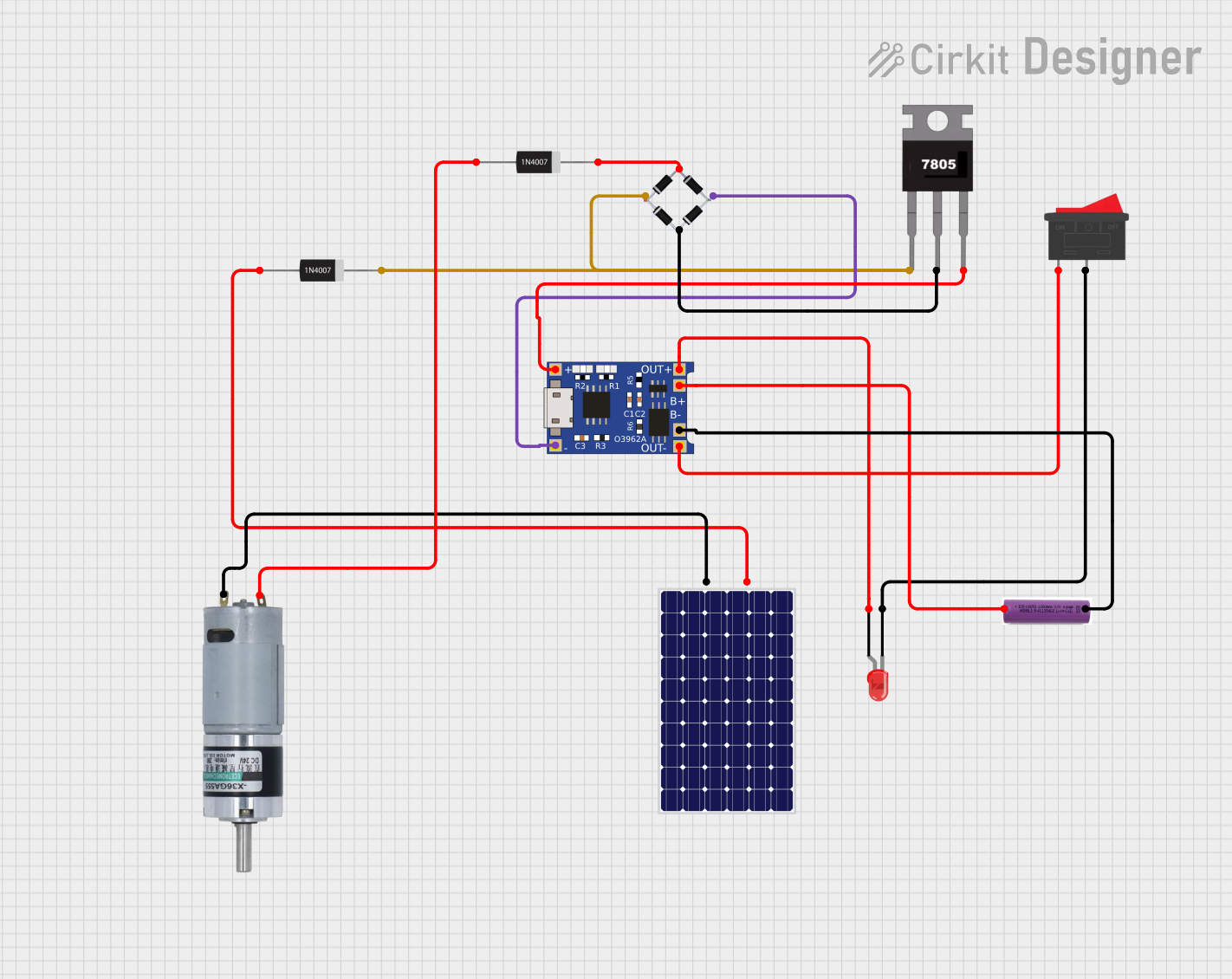
This circuit is a solar-powered battery charging and motor control system. The solar panel charges a 3.7V battery through a TP4056 charging module, which also powers an LED indicator via a rocker switch. Additionally, the circuit includes a motor driven by the battery, with a 7805 voltage regulator and bridge rectifier ensuring stable power delivery.
 Open Project in Cirkit Designer
Open Project in Cirkit DesignerSolar-Powered Battery Charging System with Voltage Display and Regulation
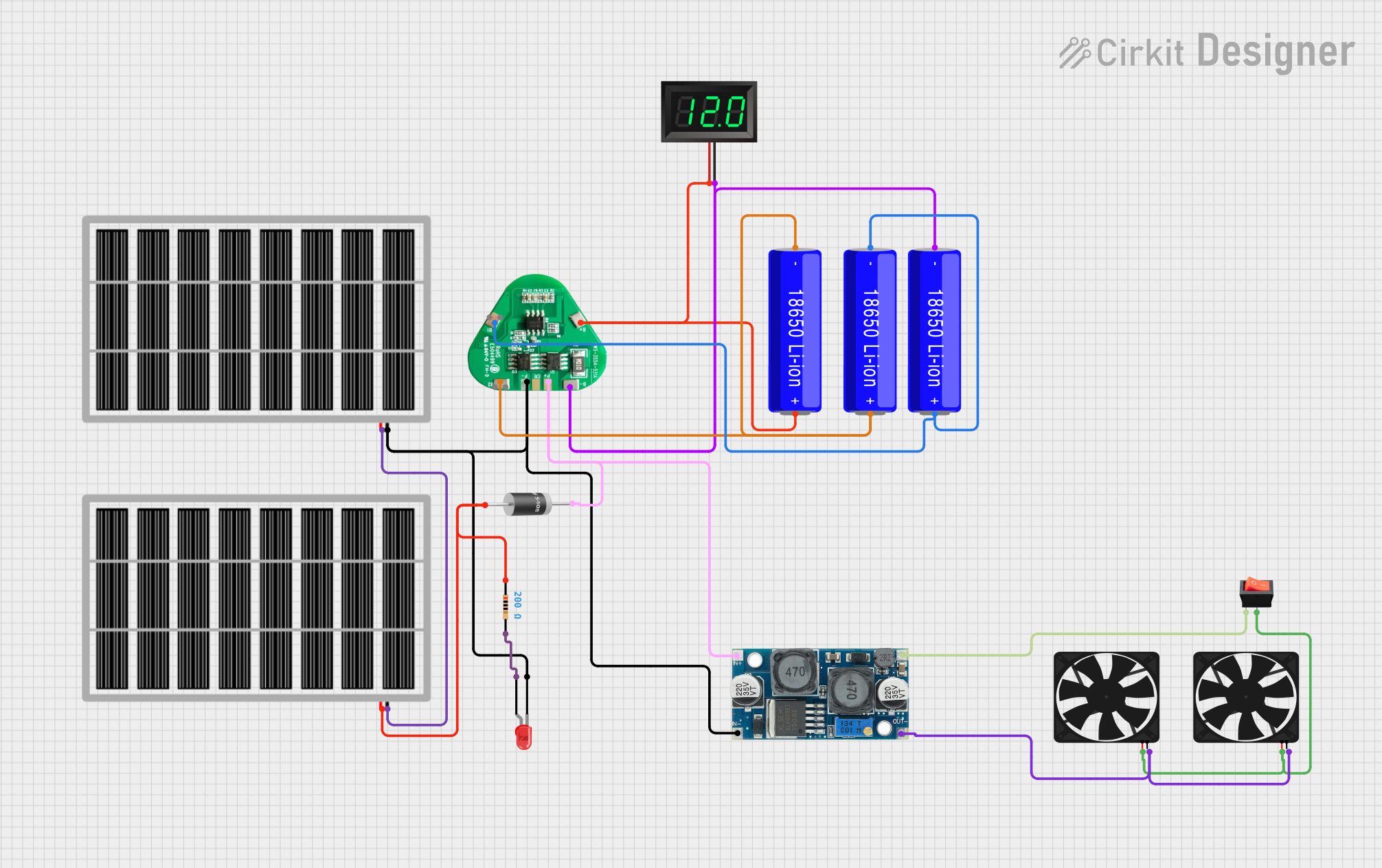
This is a solar-powered battery charging and power supply circuit with a battery management system for 18650 Li-ion batteries. It includes a voltage regulator for stable power delivery to fans, a visual power indicator LED with a current-limiting resistor, and a voltmeter to monitor battery voltage. A rocker switch controls the fans, and diodes are used to prevent reverse current flow.
 Open Project in Cirkit Designer
Open Project in Cirkit DesignerSolar-Powered Battery Charging Circuit with LED Indicator
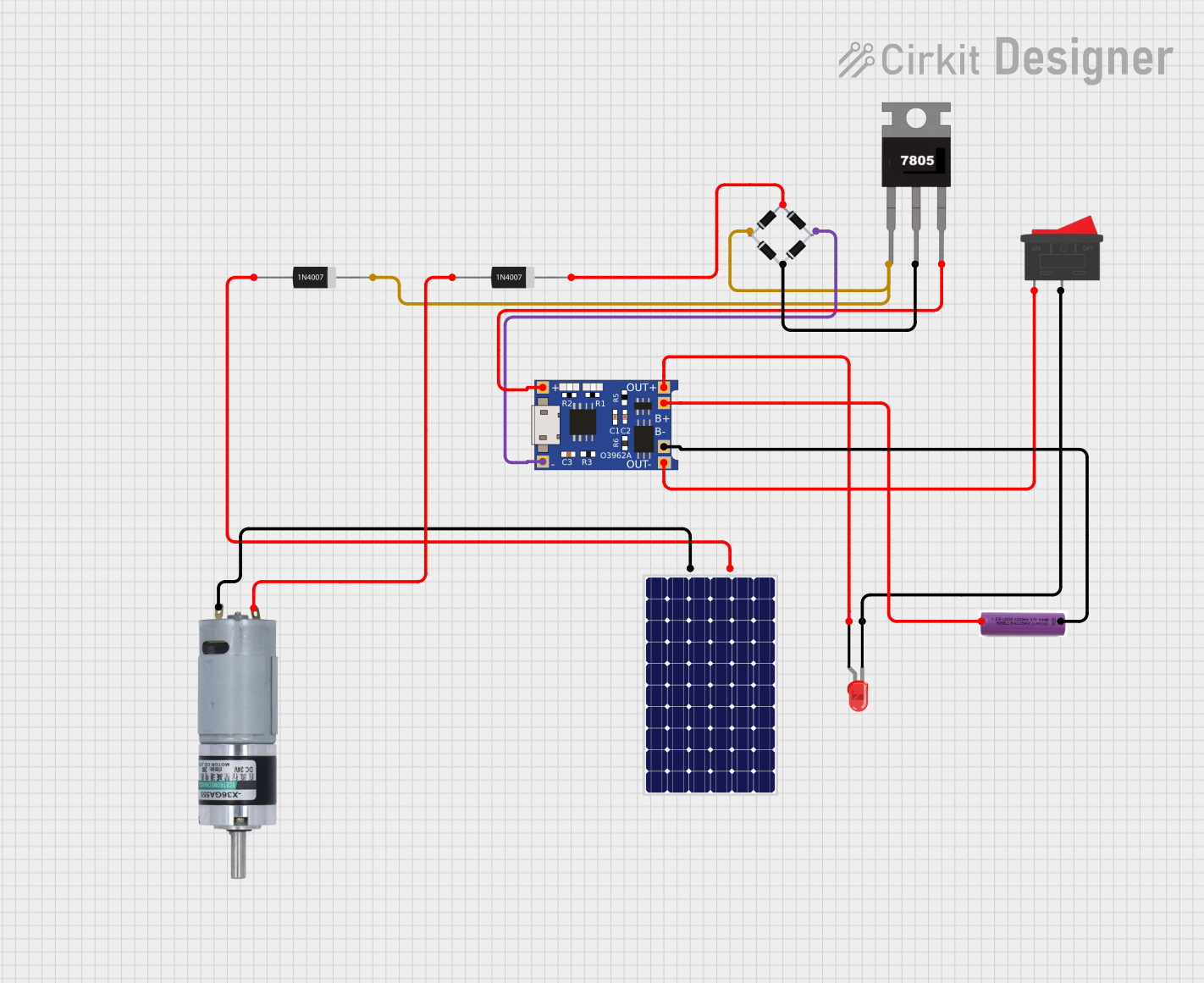
This circuit appears to be a solar-powered charging and power supply system with a battery backup. A TP4056 module is used for charging the 3.7V battery from the solar panel via a bridge rectifier, ensuring proper battery management. The system can power an LED and a motor, with a rocker switch to control the LED, and diodes are used to provide correct polarity and prevent backflow of current.
 Open Project in Cirkit Designer
Open Project in Cirkit DesignerBattery-Powered Adjustable Voltage Regulator with Li-ion 18650 Batteries and BMS
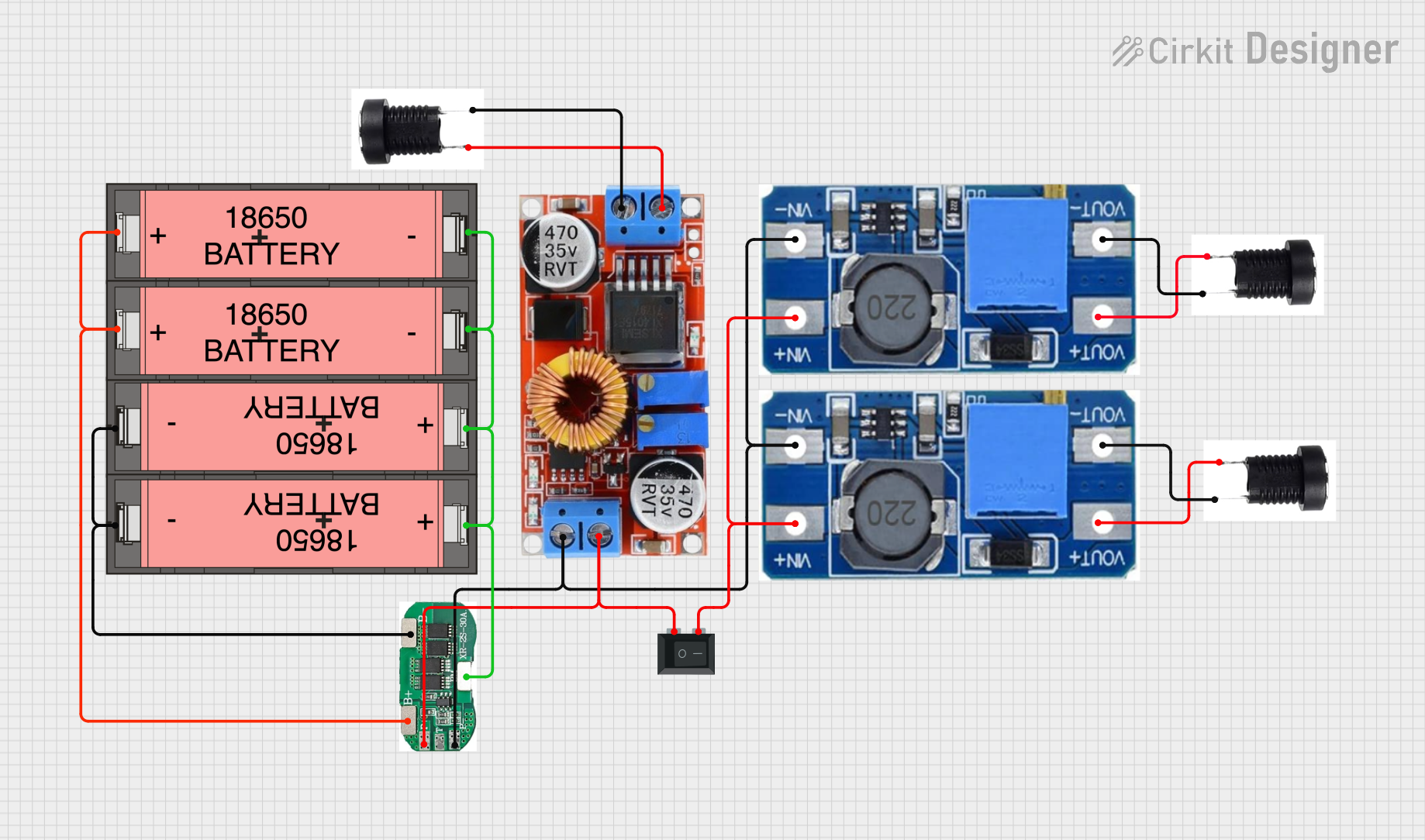
This circuit is a power management system that uses four Li-ion 18650 batteries connected to a 2S 30A BMS for battery management and protection. The system includes step-up and step-down voltage regulators to provide adjustable output voltages, controlled by a rocker switch, and multiple DC jacks for power input and output.
 Open Project in Cirkit Designer
Open Project in Cirkit DesignerExplore Projects Built with battery

Solar-Powered Battery Charger with LED Indicator and Motor Control
This circuit is a solar-powered battery charging and motor control system. The solar panel charges a 3.7V battery through a TP4056 charging module, which also powers an LED indicator via a rocker switch. Additionally, the circuit includes a motor driven by the battery, with a 7805 voltage regulator and bridge rectifier ensuring stable power delivery.
 Open Project in Cirkit Designer
Open Project in Cirkit Designer
Solar-Powered Battery Charging System with Voltage Display and Regulation
This is a solar-powered battery charging and power supply circuit with a battery management system for 18650 Li-ion batteries. It includes a voltage regulator for stable power delivery to fans, a visual power indicator LED with a current-limiting resistor, and a voltmeter to monitor battery voltage. A rocker switch controls the fans, and diodes are used to prevent reverse current flow.
 Open Project in Cirkit Designer
Open Project in Cirkit Designer
Solar-Powered Battery Charging Circuit with LED Indicator
This circuit appears to be a solar-powered charging and power supply system with a battery backup. A TP4056 module is used for charging the 3.7V battery from the solar panel via a bridge rectifier, ensuring proper battery management. The system can power an LED and a motor, with a rocker switch to control the LED, and diodes are used to provide correct polarity and prevent backflow of current.
 Open Project in Cirkit Designer
Open Project in Cirkit Designer
Battery-Powered Adjustable Voltage Regulator with Li-ion 18650 Batteries and BMS
This circuit is a power management system that uses four Li-ion 18650 batteries connected to a 2S 30A BMS for battery management and protection. The system includes step-up and step-down voltage regulators to provide adjustable output voltages, controlled by a rocker switch, and multiple DC jacks for power input and output.
 Open Project in Cirkit Designer
Open Project in Cirkit DesignerCommon Applications and Use Cases
- Portable Electronics: Smartphones, laptops, and tablets.
- Wearable Devices: Smartwatches and fitness trackers.
- Remote Controls: TV remotes, garage door openers.
- Automotive: Car batteries, electric vehicles.
- Renewable Energy Systems: Solar power storage.
- Backup Power Supplies: Uninterruptible power supplies (UPS).
Technical Specifications
Key Technical Details
| Parameter | Description |
|---|---|
| Voltage | The electrical potential difference (e.g., 1.5V, 3.7V, 12V) |
| Capacity | The amount of charge a battery can store (e.g., 1000mAh) |
| Chemistry | The chemical composition (e.g., Li-ion, NiMH, Alkaline) |
| Discharge Rate | The rate at which the battery can deliver current (e.g., 1C) |
| Cycle Life | The number of charge/discharge cycles a battery can endure |
| Operating Temperature | The temperature range within which the battery operates efficiently |
Pin Configuration and Descriptions
| Pin Number | Pin Name | Description |
|---|---|---|
| 1 | Positive (+) | The positive terminal of the battery |
| 2 | Negative (-) | The negative terminal of the battery |
Usage Instructions
How to Use the Battery in a Circuit
- Identify the Terminals: Ensure you correctly identify the positive (+) and negative (-) terminals of the battery.
- Connect to the Load: Connect the positive terminal to the positive side of the load and the negative terminal to the negative side.
- Secure Connections: Use appropriate connectors or soldering techniques to ensure secure and stable connections.
- Monitor Voltage: Regularly check the battery voltage to ensure it remains within the specified range for your application.
Important Considerations and Best Practices
- Polarity: Always connect the battery with the correct polarity to avoid damage to the circuit.
- Overcharging/Overdischarging: Use a battery management system (BMS) to prevent overcharging and overdischarging.
- Storage: Store batteries in a cool, dry place to extend their lifespan.
- Disposal: Dispose of batteries according to local regulations to prevent environmental harm.
Example: Connecting a Battery to an Arduino UNO
// Example code to read battery voltage using Arduino UNO
// Connect the positive terminal of the battery to the A0 pin
// and the negative terminal to the GND pin of the Arduino UNO.
const int batteryPin = A0; // Analog pin to read battery voltage
float batteryVoltage = 0.0;
void setup() {
Serial.begin(9600); // Initialize serial communication
}
void loop() {
int sensorValue = analogRead(batteryPin); // Read the analog value
batteryVoltage = sensorValue * (5.0 / 1023.0); // Convert to voltage
Serial.print("Battery Voltage: ");
Serial.println(batteryVoltage); // Print the voltage
delay(1000); // Wait for 1 second before next reading
}
Troubleshooting and FAQs
Common Issues Users Might Face
- Battery Not Powering the Circuit:
- Solution: Check the connections and ensure the battery is charged.
- Battery Overheating:
- Solution: Ensure the battery is not overloaded and is within the operating temperature range.
- Short Battery Life:
- Solution: Verify the battery capacity and discharge rate are suitable for your application.
Solutions and Tips for Troubleshooting
- Check Connections: Ensure all connections are secure and free from corrosion.
- Use a Multimeter: Measure the battery voltage and current to diagnose issues.
- Inspect for Damage: Look for any physical damage or swelling in the battery.
FAQs
Can I use any battery with my device?
- No, always use a battery that matches the voltage and capacity requirements of your device.
How do I know when to replace my battery?
- Replace the battery when it no longer holds a charge or shows signs of physical damage.
Is it safe to leave a battery connected to a charger?
- Only if the charger has overcharge protection. Otherwise, it can damage the battery.
By following this documentation, users can effectively utilize batteries in their electronic projects, ensuring safety and optimal performance.